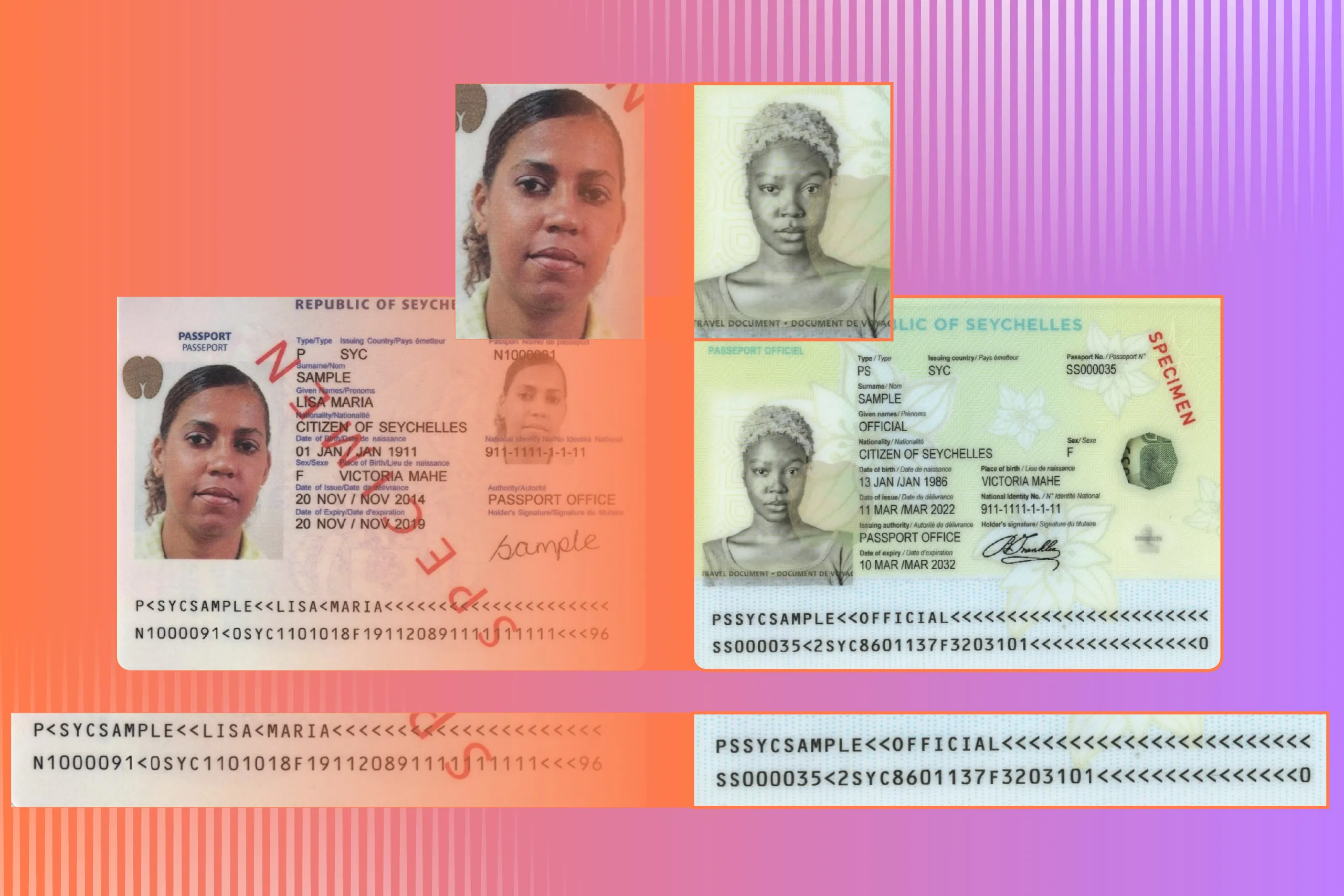As part of the EU, Malta shares some common features with other member states, including its identity documents. However, Maltese IDs stand out as a reflection of the unique cultural and political heritage.
In this article, we explore both the shared and distinct characteristics of Maltese IDs.
The challenges of processing Maltese IDs
Malta is an island country in the Mediterranean Sea, made up of six islands, three of which are inhabited: Malta (home to the capital, Valetta), Gozo, and Comino. With a population of just around 542,000, Maltese citizens hold some of the rarest IDs in the world.
Let’s take a closer look at these documents and highlight their most interesting features.
Maltese passport: One country, two nations
Malta’s current passport is an ICAO-compliant travel document with a burgundy cover, common for EU countries. The previous 2008 series, with a paper-based data page, will remain in circulation at least until 2029.

Although biometric, the 2008 passport series still lacks advanced security features, especially on the data page, making it more vulnerable to fraud and easier to counterfeit. These shortcomings were addressed in the latest version, which offers significantly enhanced security.
The passport from 2019 features a polycarbonate data page, which includes standard personal information. Dates of birth, passport issuance, and expiration are shown in French and English, while the other fields are in English only. An RFID chip holds the bearer’s facial image as biometric data, enabling NFC-based verification.

The 2019 series features a polycarbonate data page with advanced security features like a transparent window, Kinegram, and MLI. The country name, data fields, and inscriptions on the cover appear in Maltese, one of the official languages.
In addition to standard security features, the Maltese passport has dynamic ones that can be checked during liveness detection. These include a hologram (Kinegram) and a Multiple Laser Image (MLI) displaying the holder’s ghost portrait and birthdate.

Located to the right of the portrait, the hologram overlaps the Sex and Date of Issue fields. This can cause glare in mobile scans, complicating OCR.

During online verification, the birthdate in the MLI can be read and used for cross-checking.
Interestingly, a Maltese passport also grants Commonwealth citizenship. This allows holders to apply for British emergency passports if theirs is lost or stolen (with national government approval). In the UK, they can vote and even run for public office.
Besides the ordinary passport, a rare few—both Maltese and internationals—can bear a passport from the Sovereign Military Order of Malta. Known as the Knights of Malta, the Order is a Catholic institution with nearly 1,000 years of history. It has no territory, but holds UN observer status and issues its own ICAO-compliant passports under the country code XOM, unlike Malta’s MLT.
The Order issues two passport types:
Diplomatic: For members of the Sovereign Council and diplomatic staff, including their spouses and minor children. Validity depends on assignment duration—up to ten years for Grand Masters.
Service: For those on specific missions, including humanitarian personnel and officials working in areas of danger. Validity matches the assignment period.

Since 2005, when the current series was introduced, both diplomatic and service passports—red and black, respectively—have been biometric and ICAO-compliant. It's interesting to imagine what they looked like back in the 1300s, when passport issuance first began.
These paper-based passports have the same data page layout with standard personal details specified in French. One peculiarity: they include “Height,” which is more common in Asian travel documents. Also, they omit the word “Passport” at the top—not following one of ICAO’s recommendations.
As the Order accepts international members, the Place of birth field varies widely.

Although the Order issues non-standard passports, they contain the 'P' type code, rather than 'PD' or 'PO', which are used for diplomatic and service passports, respectively. However, the passport type is indicated in the document number, which starts with 'S' for service and 'D' for diplomatic passports.
These passports come with non-dynamic security features, like UV elements, but the electronic chip ensures secure online verification.
The Order currently maintains full diplomatic relations with at least 115 countries worldwide. According to officials, these states—as well as most Schengen members—recognize and accept the Order’s diplomatic passports as valid travel documents. However, they definitely impress border control officers, being the rarest passports in the world. Today, around 500 diplomatic and only about 50 service passports are in circulation.
Maltese driver’s license: The only Semitic language with Latin script
Malta issues driver’s licenses in line with EU standards, including the Union flag emblem on the front and a layout featuring numbered data fields. This makes them valid across the EU as well as in countries that are party to the Geneva Convention on Road Traffic.
As a domestic document, the license uses the national language—Maltese. While Maltese belongs to the Semitic language group, like Arabic and Hebrew, it is the only Semitic language that uses the Latin script, enhanced with unique diacritic marks such as ħ, ġ, and ż.
Maltese appears on the license in the sixth field (Address), requiring a system that supports this language for accurate OCR and processing. However, the intricate background pattern may hinder recognition in low-light conditions or when the image is out of focus.
The document also includes dynamic security features like a hologram, an Optically Variable Ink (OVI) element, and an MLI with the birthdate and ghost portrait—all of which can assist in liveness checks.

Malta’s EU-style license includes standard features such as an MLI and OVI, along with a distinct national cross symbol.
To obtain a driver’s license in Malta, applicants must be at least 18 years old. New drivers receive a probationary license valid for three years. This can be upgraded to a full 10-year license if the driver accrues fewer than 12 penalty points—or none at all—during the probation period.
Maltese identity card: A EU-valid travel document
Maltese citizens hold a national identity card that is valid for travel within the EU countries, which are in the Schengen zone. This gives the card a broader international scope, making it more likely to be used for identity verification in industries like travel and hospitality.
The Maltese identity card is biometric and includes standard personal details. Some fields, like place of birth and address, may be in Maltese. It also includes a CAN (Card Access Number)—represented in digits on the front and a QR code on the back—used for reading the electronic chip. This QR code is standard: it contains plain text, unlike the code in the new portrait-oriented Icelandic ID card, which follows the ICAO-compliant structure (ICAO Datastructure for Barcode, 2023).
The Maltese identity card also contains a unique ID number, which matches the number found in the holder’s passport and the machine-readable zone. This number consists of seven digits and one letter. The first five digits represent the individual’s birth registration number, and the final two refer to the year of registration. The letter indicates the following:
A – Foreigners with a residence permit
G – Gozitan residents registered between 1900–1999
H – Gozitan residents registered after 2000
L – Maltese residents registered after 2000
M – Maltese residents registered between 1900–1999
P – Maltese citizens born abroad who lack an original birth certificate for local registration
Historic letters include Z for Gozitan residents registered between 1800–1899, and B for Maltese citizens registered in the same period.
During identity checks, the ID number can be cross-verified with the machine-readable zone (MRZ), along with other personal data from the visual inspection cone (VIZ).
Dynamic security features include an MLI that combines a ghost image and birthdate—matching other Maltese IDs—and a hologram.
How to effectively process Maltese IDs
At first glance, Maltese ID cards, driver’s licenses, and passports appear standard in terms of content and ICAO-compliant layout and format. However, a closer look reveals specifics that your IDV solution should be ready to handle:
Support for the Maltese language, which appears in domestic documents and some data fields in travel documents.
Inclusion of Knights of Malta document templates in your database—even though encountering one is rare.
NFC verification capabilities, as both Maltese passports and ID cards are biometric.
Liveness detection for IDs, since most include dynamic security features that need to be verified.
MRZ and barcode reading capabilities.
Primary and secondary portrait matching, primarily in Maltese driver’s licenses and ID cards.
Still have questions about verifying identity documents? Feel free to book a call with one of Regula’s representatives—we’ll respond to your request right away.





